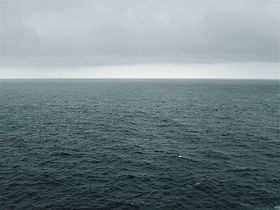 |
| World Ocean |
Today's post is a study of certain aspects of the World Ocean Database user's manual (Johnson, D.R., T.P. Boyer, H.E. Garcia, R.A. Locarnini, O.K. Baranova, and M.M. Zweng, 2013. World Ocean Database 2013 User’s Manual. Sydney Levitus, Ed.; Alexey Mishonov, Technical Ed.; NODC Internal Report 22, NOAA Printing Office, Silver Spring, MD, 172 pp, doi:10.7289/V5DF6P53. The manual is available for a no-cost download at http://www.nodc.noaa.gov/OC5/WOD13/docwod13.html).
That manual presents, among other things, maximum and minimum ocean temperatures and salinity values at thirty-three (33) ocean depths.
Snapshots of those values are presented in Appendix QO-1.
Those thirty-three WOD depths (L1-L33) also make-up the five Pelagic Depths (Epipelagic, Mesopelagic, Bathypelagic, Abyssopelagic, and Hadopelagic) which are depicted in the graphs in Appendix QO-2 and Appendix QO-3.
Those depths are:
L1-L9.......Epipelagic.........(10-200m)
L10-L18...Mesopelagic.....(201-1000m)
L19-L29...Bathypelagic.....(1001-4000m)
L30-L32...Abyssopelagic...(4001-5500m)
L33..........Hadopelagic......(>5500m)
In a paper I recently quoted from, the authors complained that "long‐term, continuous observations of temperature deep within the ocean are exceedingly rare" (In Search Of Ocean Heat - 9).
Let me point out that those "observations" (measurements) are not so exceedingly rare that scientists Johnson, Boyer, Garcia, Locarnini, Baranova, Mishonov, Levitus, and Zweng were unable to ascertain relevant maximum and minimum values for those ocean depths around the globe (see WOD link in the first paragraph of this post, and Appendix QO-1).
The next post in this series is here, previous post in the series is here.
No comments:
Post a Comment